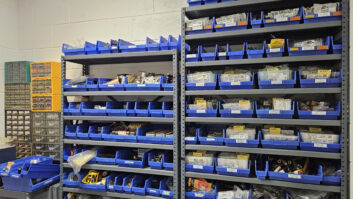(click thumbnail)The Pioneer DVR-A03 disc burner is an evolutionary leap in mass storage. With the ability to store up to 4.7 GB of data on a single disk, the A03 is a near-ideal solution for archiving massive amounts of audio production.
The DVR-A03 is the first CD/DVD recorder aimed at a mainstream audience. While the prior generation of DVD-Rs cost more than $5,000, this one comes in just under the $1,000 mark. Blank disc prices have fallen as well. Clocking in at about $30 last year, they can now be had for less than $10.
Although that is not quite as cheap as the CD-R in terms of dollars per megabyte of storage, the convenience of not having to hassle with using numerous CDs to store large projects may be worth the price.
Product CapsuleThumbs Up:
Easy install, enormous capacity, fast recording speeds
‘Lossless Linking’ buffer underrun protection
Thumbs Down:
Still relatively high cost per MB
For more information contact Pioneer New Media Technologies in California at (310) 952-2111 or visit the Web site at www.pioneerprodj.com.
Features
Basically, the DVR-A03 is an ATAPI CD-R/RW with the added capability of reading/recording/rewriting the higher capacity DVD data format. As a CD burner, it is an 8x/4x/24x drive with a 2 MB data storage buffer and lossless linking (burn proof) to prevent underruns.
The unit records at up to 8x real time, records rewritables at up to 4x real time and reads at up to 24x real time. Given the market glut of up to 16x real-time CD recording speeds, that is nothing special.
The CD performance is not the main reason to buy this unit, however. As a DVD, it writes at twice real time (or, more precisely, 2.8 MB/sec), rewrites at real time (1.4 MB/sec), and reads at up to 4x real times (5.9 MB/sec).
The 2x DVD write speed is fast even by CD-R standards. A 16x CD-R is only recording at 2.4 MB/sec. Given the far greater data capacity, the need for such high speeds becomes obvious.
In use
Installing the DVR-A03 was as easy and popping in any ATAPI CD-R. I tested it in an all-SCSI system so I had to reset the BIOS to activate the IDE compatibility. Once in place, Windows 2000 identified it properly.
The next step was installing the DVR software bundle. Most of the included software was intended to help consumers in burning video DVDs. For data purposes, the Prassi Primo DVD software is the familiar CD-R recording package included with many CD-Rs, but with DVD enhancements.
The simple, menu-driven system was so intuitive that no manual was needed to navigate basic operation. I was ready to burn a test disc in minutes.
The first experiment was with DVD-RW. Because DVD-R blanks are still relatively expensive ($10), the rewritable seemed a safe bet. The first session went flawlessly. The system recorded 4 GB of data and the disc was ready to read.
Both the reading (and erasing) of the disc took just under an hour. (Incidentally, the stated 4.7 GB is actually about 4.4 GB.)
When I started working with DVD-R discs I was able to write at twice the speed. I experienced one failure that was later determined to be a problem with the operating system. After a fresh installation of Windows 2000, the drive performed flawlessly.
Given the fast burn speeds needed to save all that data, the lossless linking is crucial to avoid buffer underruns. Without this, the high data demands would undoubtedly challenge hard drives to keep up.
DVD format
A few notes about the DVD format itself are worth mentioning.
The DVD recorder has been a long time in coming. For the past few years, there has been some confusion over the DVD format. Several competing standards offered by manufacturers appeared.
The format wars raged over whether the DVD discs should be naked, like the CD, or enclosed in a protective case, like the MiniDisc.
The attraction of enclosed discs is durability. Anyone who has suffered trying to recover audio or data from a badly scratched CD knows that naked discs are vulnerable. With CD-Rs it is even worse. Not only can scratches on the bottom degrade readability, but tearing the thin recording layer on top will destroy a disc.
With DVDs, the vulnerability issue is magnified because the data density – the amount of information in a given area on the disc – is nearly 10 times as great as it is on a CD. What seems a small scratch on a CD can be far more destructive on a DVD.
Despite the increased risk, it appears that the DVD recording format is destined to go the way of the CD and not the MiniDisc. The burgeoning home DVD market has decided this. Recordable discs must be compatible with the players that are quickly replacing VCRs.
That being said, I did not find these discs to be particularly fragile. But it is worth remembering that scratches on a DVD could be costly.
Take a little care
With a little care to keep discs in the included jewel box for safekeeping, the discs should be just fine. Leaving them lying around the studio is not a good idea. But the same could be said for CD-Rs.
After my experiments with the DVR-A03, I can see how this could quickly obsolete the CD-R only market.
If past trends hold – and prices for both media and recorders drop – DVD-Rs will be ubiquitous within three years. The smaller CD discs will likely remain available for a long time; they are very cheap and will do for many smaller tasks.
The ability to store far larger archives, however, is attractive and will become nearly irresistible as demands for storage increases much as prices drop.











